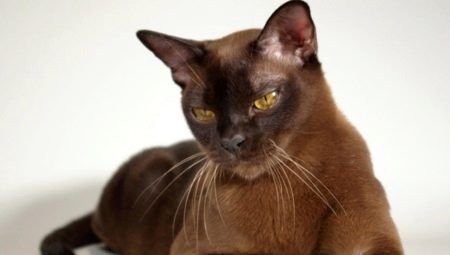Brown cats are not just pets, but symbols of harmony, stability and tranquility. Devotion and the ability to train make them similar to dogs. The right pet and proper care will help you find a true friend who will accompany your master everywhere.
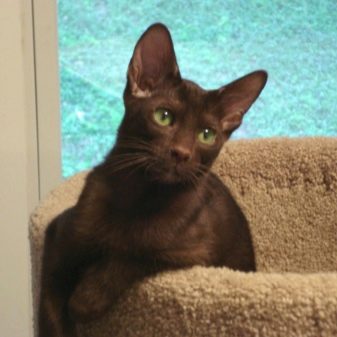
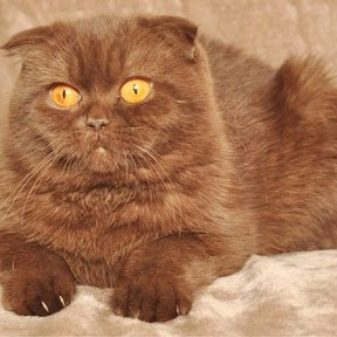
Features
All breeds with brown wool are bred artificially.
Only parents have a direct influence on the formation of color, the rest of the pedigree does not transmit their genes the color of the coat. Fur seals inherit color from their mothers, cats receive a combination of coat color from both parents.
Brown cats have an unusual character: they are very dependent on their owners.
If a cat or cat is left unattended, the animal may become depressed and lose interest in life, begin to get sick and lose weight.
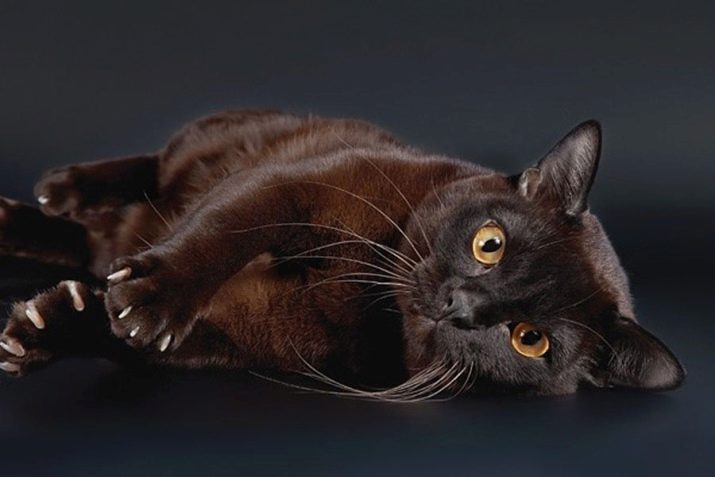
All individuals of brown breeds have common traits:
- good nature;
- curiosity;
- sociability;
- friendliness;
- increased activity;
- playfulness;
- devotion.
Representatives of brown breeds are extremely difficult to tolerate separation from the owner, so it is recommended to travel with them. On the road they are unpretentious, easily adaptable and ready to go after the owner to the ends of the world.
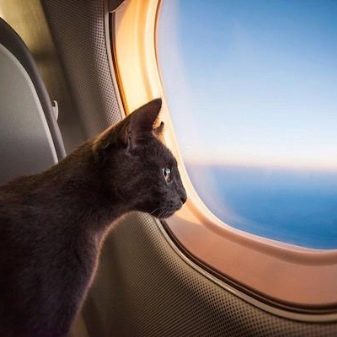
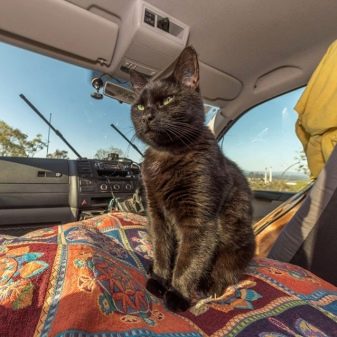
Brown pets are easy to train, like to bring a ball to the owner.
Individuals with a marriage in color are not allowed to exhibitions, because the appearance does not meet accepted standards. They are also not allowed to mate, as they have poor health, and genetic diseases may appear in subsequent generations. It is recommended to sterilize such individuals.
Before purchasing a kitten, you should familiarize yourself with the appearance requirements of different breeds of brown cats.
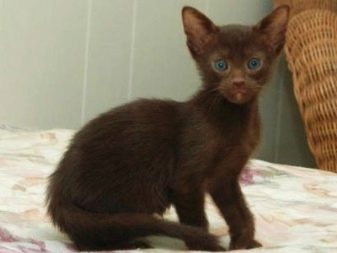

Breed list
Representatives of brown breeds have the most diverse appearance: from sophisticated smooth-haired Abyssinians to long-haired Persian fat men. Cats are larger than cats.
The Abyssinian cat was considered a sacred animal in Egypt.
Features of the appearance of the Abyssinians:
- average physique;
- weight 3-4.5 kg;
- taut developed muscles;
- short smooth coat without undercoat (therefore, molting is less noticeable than other brown cats and cats);
- color can vary from dark brown to light apricot;
- the hair on the tummy is lighter, but should not contrast with the overall color.
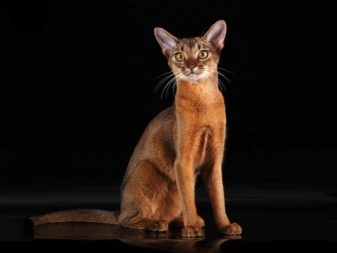

The following colors are considered brown: wild, bay and beige.
Havana also belongs to the breeds of brown cats, it was bred from crossing a Siamese cat with a black short-haired American cat (after several generations it turned out to be a persistent saturated color). It has the following symptoms:
- rather large muscular body;
- weight 4-6 kg;
- narrow muzzle and wide apart ears with an inclination forward;
- bright green eyes;
- short coat of uniform red-brown color.
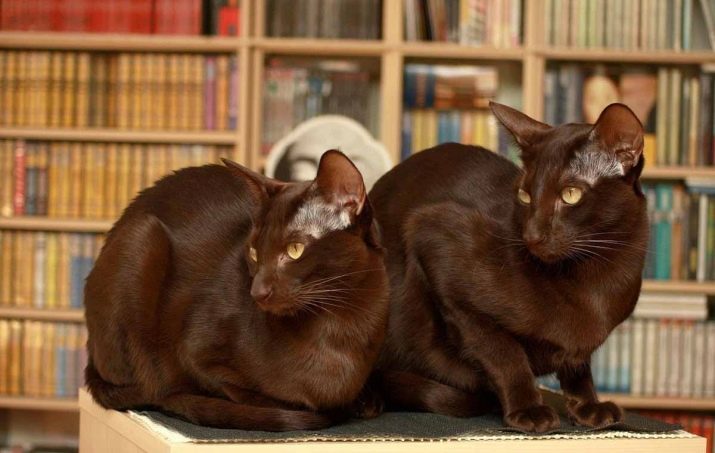
Individuals of this breed often have problems with their teeth, so it is recommended that from 4 months a kitten conduct prophylaxis of dental diseases at the veterinarian.
Chocolate Persian cat is the representative of the most lazy "sofa" breed of all brown breeds.
Distinctive features:
- muscular squat body;
- weight can reach 6-8 kg;
- strong stocky body with the right proportions;
- muzzle flattened;
- miniature upturned nose of a light coffee hue;
- thick short neck and rather massive paws;
- round head with small, low-set ears;
- round expressive eyes can vary in color from orange to copper;
- long soft coat with thick gray undercoat.
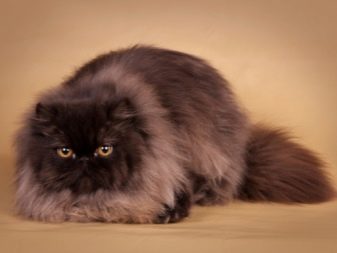
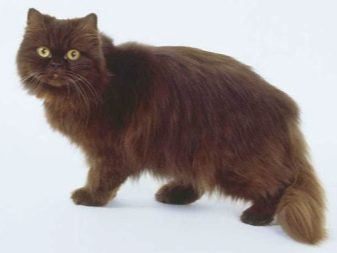
Chocolate exot is bred in America, representatives of this breed have a very capricious character.
Distinctive features:
- weighs from 4 to 7 kg;
- stocky physique;
- round head;
- massive lower jaw;
- color varies from a shade of wood bark to a rich coffee color;
- the coat is short, silky, tight to the body;
- eyes wide apart.
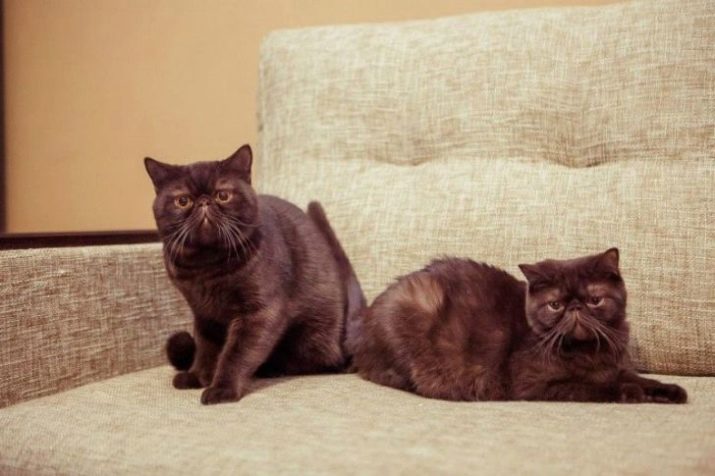
The Burmese cat is an American breed, the standard of which is acceptable in marble.
Features:
- weight from 3 to 6 kg;
- the physique is strong, muscular;
- sable color (saturated dark brown color, ears almost black) and champagne (coffee with milk, tail and muzzle brown color), while the tummy should be lighter than the back and should not contrast with the main color;
- short silky coat;
- yellow eyes are especially valued.
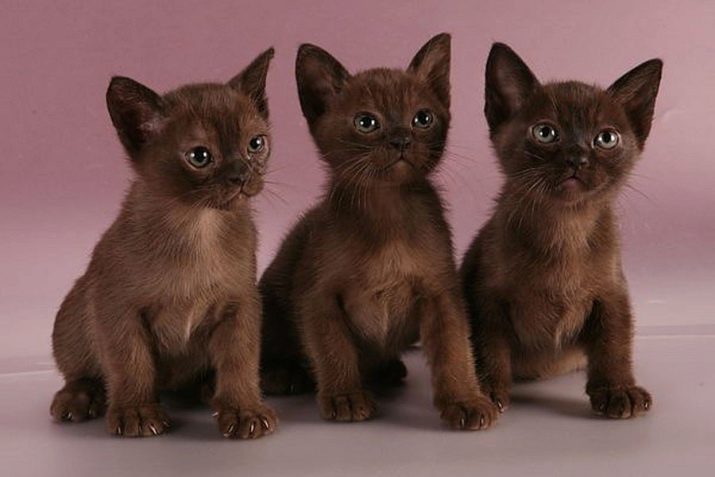
Devon Rex is the most difficult breed to breed. The individuals of this breed have an unusual appearance:
- weight from 2 to 4.5 kg;
- fragile physique;
- long thin paws and tail;
- small head with large ears;
- the muzzle is narrow;
- honey to brown color;
- curly soft six;
- almond-shaped eyes.
Devon Rex are the owners of non-standard body proportions.
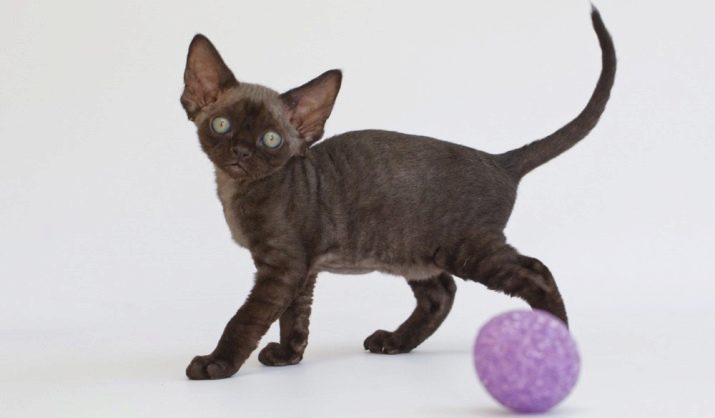
The British Chocolate Cat is a real pet teddy bear. Distinctive features are as follows:
- cats weigh from 3 kg, cats - up to 7 kg;
- strong physique;
- short paws;
- very dense shorthair with an even thicker undercoat;
- color from cream to rich chocolate.
The British color chocolate is distributed as evenly as possible throughout the body, in contrast to other brown breeds. The formation of color can last up to two years of age.
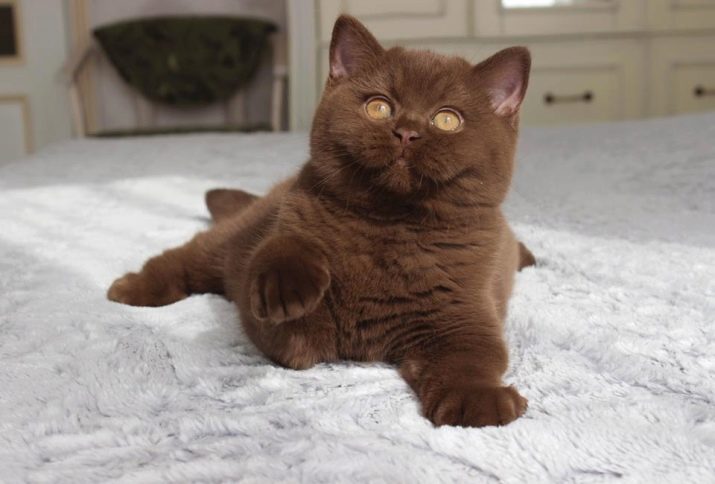
Scottish fold brown cats and cats are the result of a natural mutation:
- weight 4-7 kg;
- strong body with a wide chest;
- overhanging ears, the tips of which are inclined to the head;
- the coat is rather short and thick, with a fluffy tail;
- brown color;
- large brown or golden eyes.
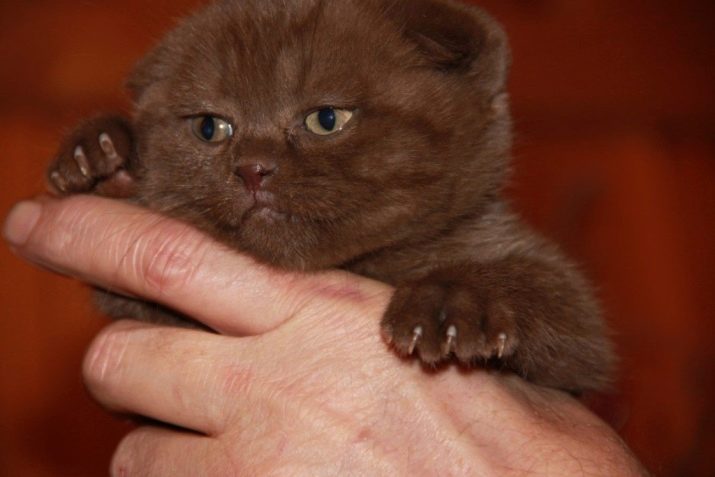
The standard of this breed allows all color variations: from a uniform brown hue to interspersed spots of any color, including marble and tiger color.
Chantilly Tiffany bred in New York.
Appearance:
- weight about 5 kg;
- elongated physique with soft contours;
- wedge-shaped head;
- silky hair without undercoat;
- fluffy tail;
- according to the standard, coloring is possible from lilac shades to brown in color with various spots or stripes;
- bright expressive golden oval-shaped eyes.
Cats and kitties of this breed have the most fluffy hair on their paws and in the collar area.
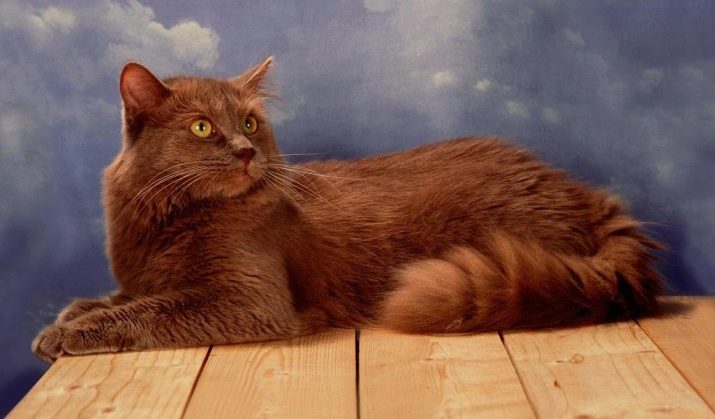
How to choose a kitten?
It is better to choose a kitten at the age of 4 months, it is at this time that all the defects of the breed are manifested. Marriage color indicates ancestral origin or improper crossbreeding.
Before buying, you must determine the gender of the animal: cats are more independent and with age can begin to avoid affection, cats are affectionate all their lives (of course, it all depends on the nature of a particular individual).
Sterilization of cats gives more complications, heals longer than castration of cats.
It is best to take kittens from acquaintances to be sure of their health status, or in nurseries with a good reputation. You should not buy pedigree kittens at a discount, this may mean that the animal is sick, they just do not reject individuals.
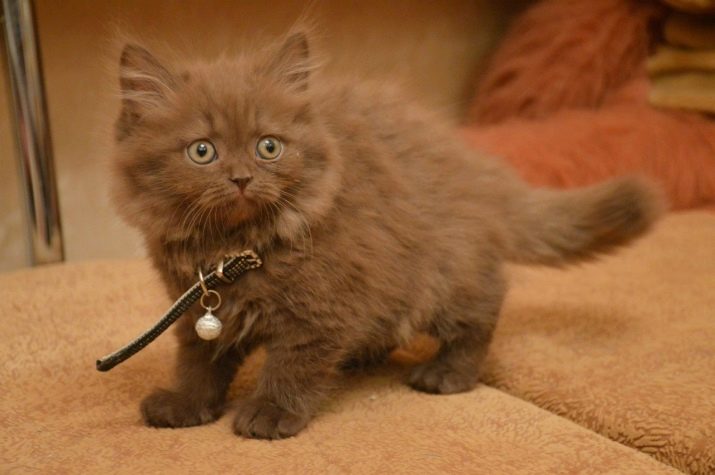
Before four months of age, it is not recommended to take kittens, the cat all this time teaches them to wash, teaches them to the tray, in addition, through the mother’s milk, the pet’s immunity for life is laid.
Immediately after acquiring a pet, it is best to take to the veterinarian for a comprehensive examination and testing for parasites, as well as for scheduling vaccinations and determining the diet.
A thoroughbred kitten must have a veterinary passport on a special form that contains the following information:
- deworming date;
- date and name of the three vaccinations;
- seal and signature of the doctor.
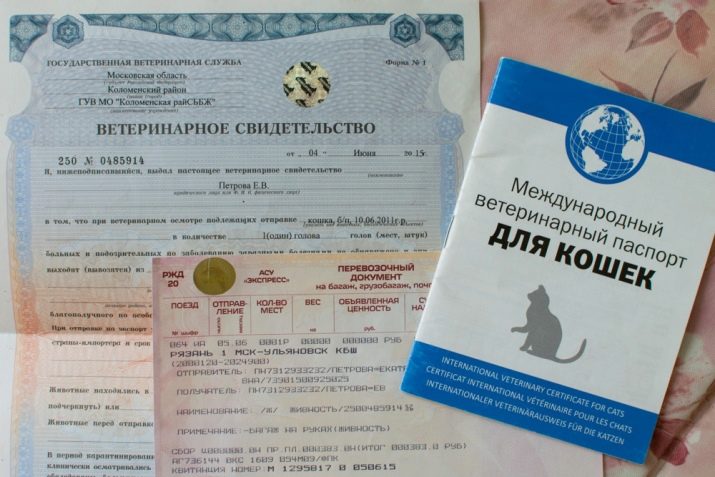
Acne or vascular mesh on the skin of a kitten indicates poor health, attempts at unsuccessful treatment (for example, bald patches are signs of lichen).
The anus should be clean, pale pink, if there is redness - the kitten most likely has worms.
Even if the kitten just woke up, his eyes should not be watery, the iris is clear, without a lint.
The ears should be clean, free from scratches and stains, both inside and out.
The kitten must follow the finger moving from side to side, if it cannot focus - problems with the development of the brain, such a kitten cannot be accustomed to the tray, with age it can become very aggressive.
Check the bite: the upper jaw should cover the lower, the wrong bite causes digestive problems, because the food will not be properly chopped.
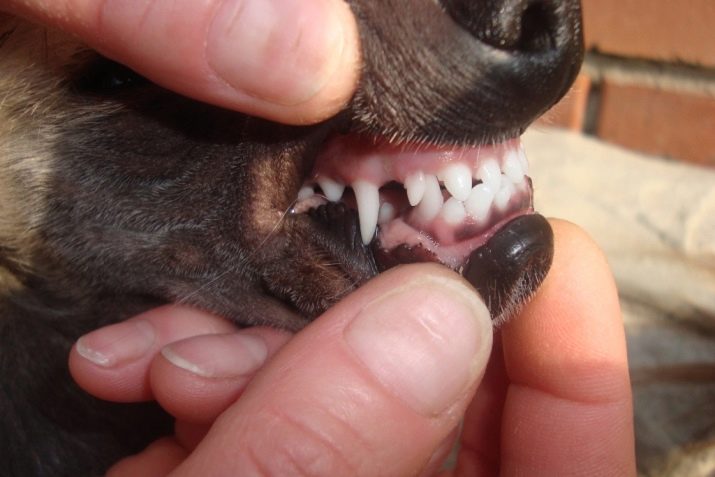
Cats with defects are not allowed to exhibitions, and are also rejected from among breeding producers.
Content Rules
The main indicator of the pet’s health is the state of the coat (in a healthy cat, the coat is silky).
Also, a healthy individual has clear eyes, clean ears and good teeth.
It is necessary to wash cats of brown breeds exclusively with special shampoos for animals, taking into account a certain type of coat. Shampoo is best chosen after consultation with a veterinarian.
A brown cat needs complex nutrition, trace elements and vitamins.
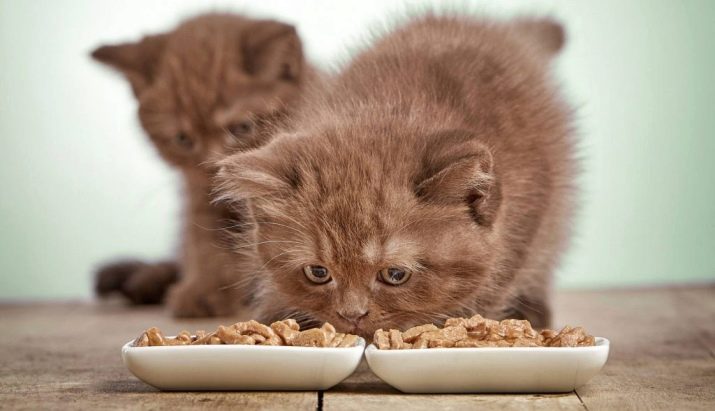
In addition to containers for food and water, cats and cats need a tray, a clawclaw, a house for rest and privacy, as well as safe toys. Long-haired individuals and cats with an undercoat will additionally need a furminator.
Proper care prolongs the life of the animal and helps maintain its health until old age.
Brown kittens, especially in early childhood, are very active, like to play and explore every corner of the apartment, with age, representatives of some breeds become phlegmatic.
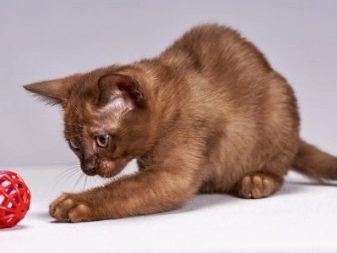
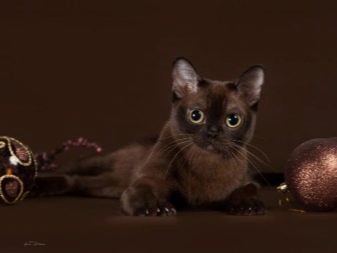
Cats of brown breeds are very friendly, sociable and curious, but they require increased attention from the owner and very difficult to tolerate separation even for one day. Such pets are best suited to homebodies, despite the fact that they travel quite easily to adapt.
All about the yore chocolate cat see in the next video.
